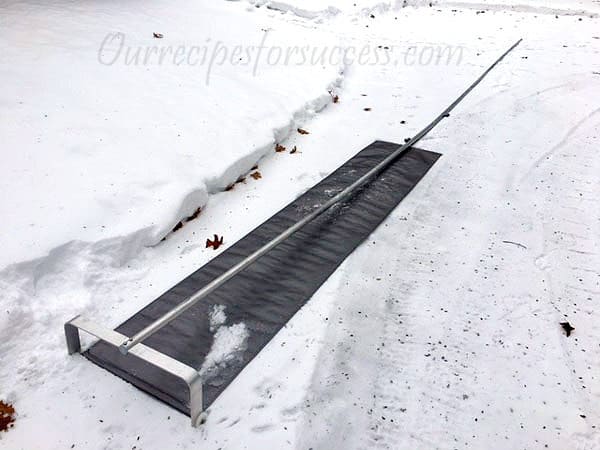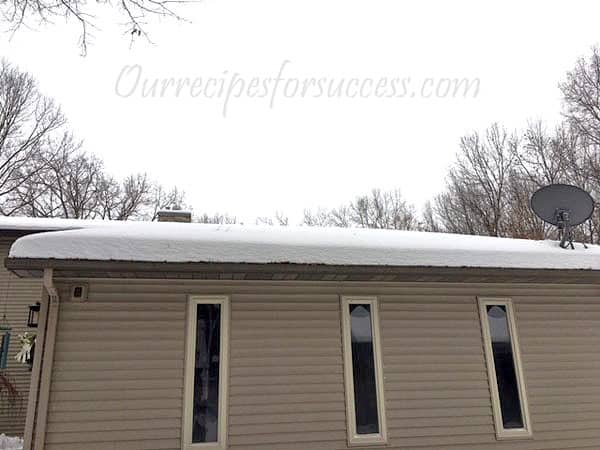Did you just receive a nice big snowfall and know you’re going to have to go out and take care of all that snow? Well, after you’re done plowing, snow blowing, and shoveling don’t forget there is one more area that you may want to consider doing some snow removal. That’s your roof! Let’s take a look at a safe and relatively quick and easy roof snow removal method that works great for most single-story homes.
My wife and I have lived in Michigan our entire lives, We know Michigan has a lot to offer the winter sports enthusiasts. Skiing, snowshoeing, ice fishing, and snowmobiling are just a few of the most popular. As a resident of Michigan or any neighboring state that receives significant snowfall, you soon learn it’s not all play.
When Is The Best Time To Shovel Snow?
Table of Contents
After a fresh snowfall, it’s always best to get out and take care of it before it gets walked or driven on. This packs it down and makes it much more difficult to move, especially if you’re shoveling or using a small snowblower.
Another scenario that will make the job more difficult is if you have a warm-up and the snow becomes wet and settles. Maybe it even melts and water starts to run a little. Then the weather cools again and all the water and wet snow begins to freeze making an icy, hard-packed mess. This scenario is the one that impacts the snow on your roof the most.
Why should I Remove Snow From My Roof?

Snow build up on a roof can lead to several problems. It can
Roof Snow Load
Homes built in different regions of the country that receive significant amounts of snow are designed to withstand the weight of the snow. It varies depending on where you live. Most homes in these regions are designed to hold several feet of “fresh” snow.
I highlight the word “fresh” above because we all know some snow is heavier than others. If you have 2’ of fluffy snow on your roof, you’re probably ok. If you have 2’ wet heavy snow on your roof, you may be getting to the point that you want to remove that snow. And as I mentioned above, the light fluffy snow can, and will, settle and become come heavier throughout the winter. In addition to that, you have to consider the accumulative effect of several small snowstorms and how they can compound the problem. Remember, crusty, packed snow is much more difficult to remove.
Roof Ice Dams

The second potential issue you may face is ice dams. They are formed when the snow melts on the roof and runs down to the eaves and then re-freezes at the eaves. This effect will continue until there is an actual build-up of ice that prevents most of the melted snow from running off the roof. Basically forming a dam.
The bad part is that in many cases that backed up water can find a way to migrate in under the roofing and get into the house. This can cause significant and expensive damage. I’ve had to repair an area with suspected ice dam damage on our roof. To see what can happen, and how to fix it, read our article on shingle roof repairs.
Ice dams are usually caused by a combination of things. Normally its a sign of poor and/or improperly installed roofing materials and attic insulation. Again, the FEMA guide has some great information on what to look for and how to take care of the problem. A good starting point is to remove the snow from your roof, at least closer to the eaves.
Roof Snow Removal Tools
Below are three of the most common tools used to remove snow from a roof. We’ll take a brief look at each and I’ll point out some of their pros and cons.
The Snow Shovel
The snow shovel is one of the most obvious options and is pretty self-explanatory. The downside of using a shovel is you’re required to physically go up on the roof to remove the snow. Unfortunately, once snow becomes compacted and frozen, it is probably the best option for removing crusty snow. Shovels can also cause damage to your roofing materials. So, care must be taken when using a shovel on a roof.
Always use fall protection when working at heights. Consider reading our articles on “Ladder Safety” and “Basic Fall Protection” for some option on how to protect yourself. Falls from slippery rooftops can cause significant injuries or worse.
Roof Rack
A roof rack is a long-handled snow removal tool used to “pull” snow down from the roof. The nice part about the roof rack is you do not have to physically go up on the roof. It is a much safer option. For the best results, you need to remove the snow while it’s fresh. They are not very effective on crusty snow.
Minnsnowta Roof Razor

The Minnsnowta Roof R
How To Use The Roof Razor

The Roof Razor comes with several handle extensions (six, 6’ extensions). It’s almost impossible to put four or more extensions on and then set it on the roof. Instead, it’s best to start with just a couple of the extensions and remove the first couple feet of snow along the eaves. Then start adding extensions to finish the job. I’ve included a couple of short videos to introduce you to the Minnsnowta roof razor and show you how effective it is. I think you will be surprised by how much fresh snow the Roof Razor can safely move!
Work Safely
If you live in a snowy region, then you know snow removal by hand can be physically exerting. There are many heart attacks and back injuries every year caused by shoveling snow. Even the roof rakes and the Roof Razor will cause physical exertion. So work smart. Take frequent breaks. Stay hydrated by drinking lots of water. Be safe.

Before Snow Removal 
After Snow Removal
If you have any comments or questions, you can leave them in the comments section below or you can email us at [email protected]. FYI, we do not collect or share email addresses. We will only use them to reply to your comments or provide answers to your questions. We are also required to let you know that some of our links are “affiliate links”. This means if you click on a link and make a purchase, we could make a small commission, at no extra cost to you. This helps offset the cost of maintaining our website. So, if you like what you’ve seen, please be sure to give us a “Like” and “Share” on Facebook and Instagram too. Thank you for reading and good luck with all your home projects!



Your assessment is spot on! Thanks for sharing your experience. Hopefully this can help others.
Snow kept piling up storm after storm, icing up in between. I researched the MinnSnowta Roof Razor, and decided to buy it. Your information is spot on. I have actually witnessed two other individuals purchasing other less effective design razors. Nothing works like the MinnSnowta. I had to have someone come and remove the majority of the cornices and ice dams. But what I “started” to do with the MRR, showed that this tool will go through layers of snow/ice (not dams). The key, as you said, is to get to the new snow quickly. Trust me, I will next time. And also, purchase the angle attach sections. Easier to get up higher. And I also purchased the 4″ wheels to make sure I would get over the metal roof heights. Thanks for you info. Colorado